|

Piave
Mill Co. (1918-1920)
Virgin
Pine Lumber Co. (1920-1933)
|
Standard gauge, 56-lb rail
Headquarters: New Orleans, LA
Mill Location: Piave, MS (Greene County)
Mill Capacity: 250,000 ft/day
Years of Operation: 1918-1933
Miles Operated: 14 miles in 1926
Locomotives Owned: 6?
|
Equipment:
1 McGiffert log loader, 1 Clyde 4-line skidder.
|
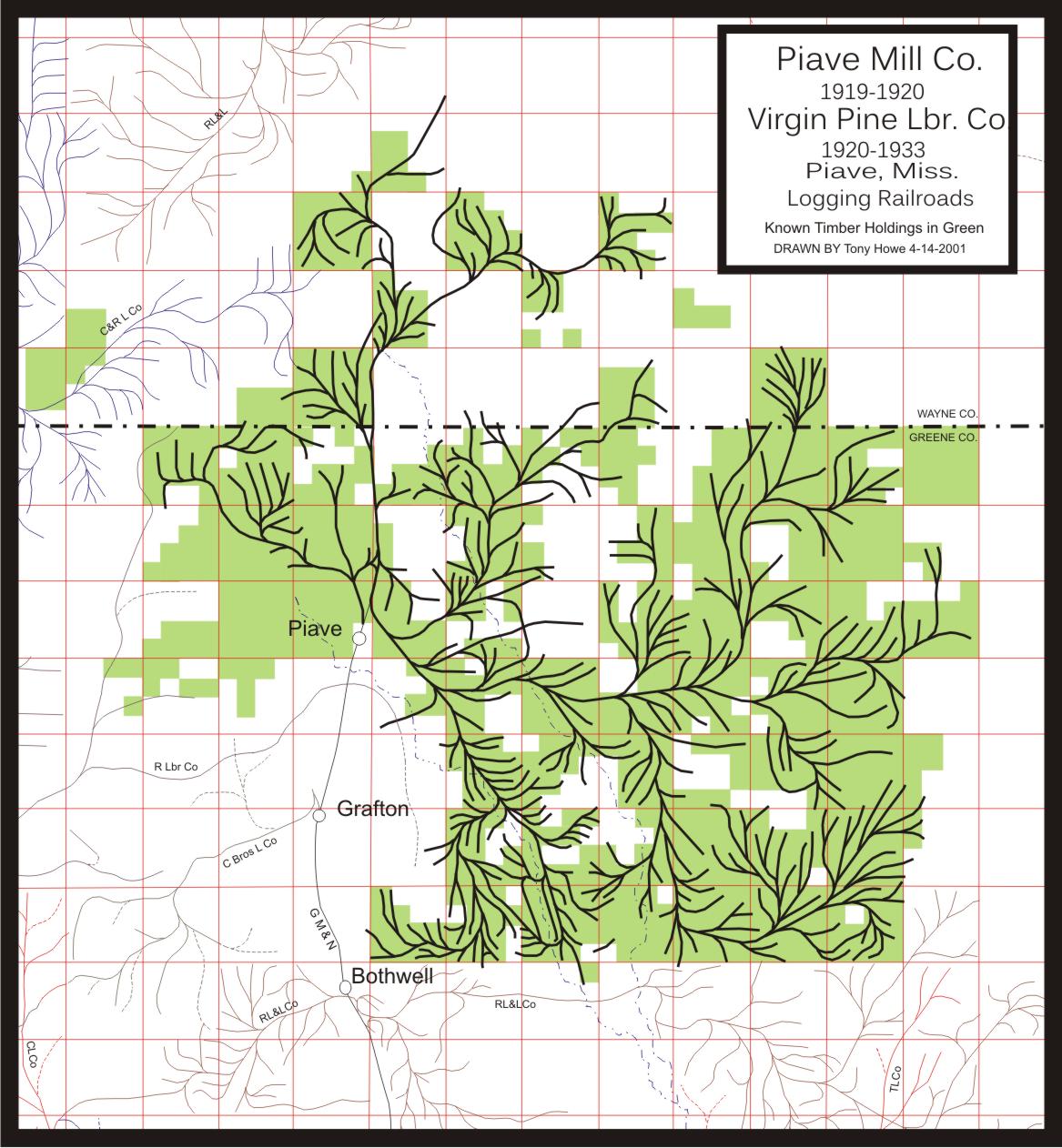
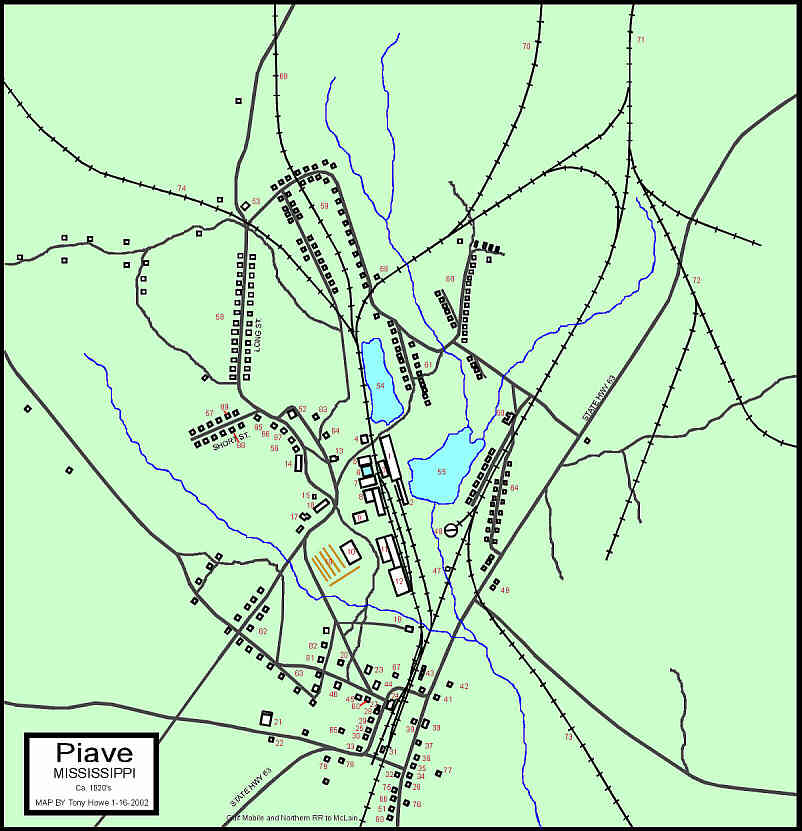
Click Map for Larger Version |
|
History
by Gil Hoffman and Tony Howe:
The
Piave Mill Company was incorporated for 50 years on August 17, 1918,
at Gulfport, Harrison County, by Henry Piaggio, W. B. Jordan and F. H.
Dickman, all of Gulfport, with capital stock of $250,000. It was a
subsidiary of the International Shipbuilding Company. Officers of the
company were P. G. Gurge-Salice, vice president, and C. Kahles, treasurer.
In October 1918, the company was operating sawmills near Ellisville, Jones
County, which cut ship material for the parent company.
On
October 7, 1918, the company contracted with John W. Blodgett, of Grand
Rapids, Michigan, for a block of his timber in Greene County. In October
1919, to cut this timber, a sawmill with a daily cutting capacity of 60,000
feet per day began operation at Piave, Greene County, on the Gulf, Mobile
& Northern Blodgett branch.
On
February 2, 1920, the sawmill (known as "sawmill No. 5"), all
lumber on hand, and the block of Blodgett timber under contract were sold to
the L. N. Dantzler Lumber Company. The operation was reorganized as
the Virgin Pine Lumber Company.
On
February 2, 1920, the L. N. Dantzler Lumber Company purchased the
sawmill plant and interest in the Blodgett timber of the Piave Mill
Company, at Piave, Greene County. To operate this property the Virgin
Pine Lumber Company was organized at New Orleans, Louisiana in May 1920
with $750,000 in capital stock. Officers of the company were J. L. Dantzler,
president; J. L. Hofstra, vice president, and E. P. Dumont, secretary and
treasurer. The mill at that time had a cutting capacity of 60,000 feet per
day. M. M. McInnis was general manager.
In
April 1923, the operation was leased with option to buy to Crosby and
Rowlands of Picayune, MS In the spring of 1924 a new double band mill
with a cutting capacity of 250,000 feet per day was built at Piave. L. O.
Crosby was general manager.
The
Piave mill cut out in November 1933.
|
The
Virgin Pine Lumber Co. Story
Or...
Where in the world is Piave, Mississippi?
By Tony
Howe
The South Mississippi town of Piave, in northern Greene County,
was home to one of the many large sawmills that were once located in
this state. During its existence, from 1917 until 1933, the sawmill at
Piave was the largest industry in northern Greene County, and provided
much traffic for Gulf, Mobile & Northern’s Blodgett Branch.
During the 1880's, facing a dwindling timber supply, many
Northern lumbermen invested in timberlands in the South. One of the
largest purchasers of Mississippi timberland was Delos A. Blodgett, from
Grand Rapids, Michigan. After two years of logging, Blodgett entered the
logging business for himself in Michigan in 1850, and invested profits
from his business in timberlands. In 1885, he began purchasing
Mississippi timberland from both the state and Federal government. By
1906 he reportedly owned 721,000 acres spread all over South
Mississippi. Most of this land was in Wayne, Greene, Jones, Perry,
Marion, Lamar, George, Jackson, Jeff Davis, and Pearl River counties.
Much of this land remained in the Blodgett family into the teens, and
was juggled back and forth between different members of the family,
including Edward Lowe, Minnie C. Blodgett, Daisy Peck Blodgett, and John
W. Blodgett. The Blodgetts, through the Blodgett Company, Limited,
also invested in timberlands in other parts of the country,
including Louisiana, South Carolina, Oregon, and California. Upon the
death of Delos Blodgett on Nov. 1, 1908, his son, John W. Blodgett, took
over as head of the Blodgett Co., Ltd. The Blodgett’s timberland in
Greene County covered much of the north half of the county, including
the area around Piave, and stretched well into Wayne County. This tract
remained untouched well into the late teens.
Several efforts were made to open up the tremendous Blodgett
timberlands in Greene, Perry, and Wayne Counties. Small tracts of the
Blodgett timber were sold to various mills that were operating along the
New Orleans, Mobile & Chicago RR, later the Gulf Mobile &
Northern RR, such as J.M. Griffin Lbr. Co. at Nomac, J.M. Hemphill at
Rhodes, Bentley & Emery at Ovett, Canal Lbr. Co. at Benmore, Wausau
Southern Lbr. at Laurel, and Richton Lbr. Co. at Richton. Other tracts
were sold to the Robinson Land & Lbr. at Chicora and the Bear Creek
Mill Co. at Leakesville. These companies extended their logging
railroads into these tracts, but large tracts of the Blodgett timber
remained untouched throughout the teens. The Alabama & Mississippi
Railroad, which ran from Vinegar Bend, Ala. to Leakesville, Miss., and
southward to Pascagoula, on the Gulf of Mexico, attempted to extend its
line from Leakesville to Laurel in 1915. The A&M was owned by the
Turner family, who owned the large Vinegar Bend Lumber Co. at Vinegar
Bend. They planned to use the Bear Creek Mill Company logging railroad,
which ran from Leakesville northwesterly to the community of Jonathan.
The A&M would build a new railroad from Jonathan, through the middle
of the Blodgett timberlands, to southwestern Wayne County, where they
would connect with the logging railroad of the Wausau Southern Lumber
Co., which ran all the way to their mill on the south side of Laurel.
The A&M hoped to acquire much lumber traffic from the large mills at
Laurel to deliver to the port at Pascagoula for export. As this would
siphon much traffic from the Gulf, Mobile & Northern RR, they were
very much against this. In an effort to prevent the construction of the
A&M line to Laurel, and to open up the remainder of the Blodgett
timberlands, the GM&N began construction of what became known as the
Blodgett Branch in 1917. The line was initially planned to run from
Richton to Waynesboro, but the junction with the GM&N mainline was
soon moved to a point near McLain, Miss. The line crossed the Leaf River
at McLain, and ran northeast and then northward through the middle of
the Blodgett timberlands, into the middle of Wayne County. Although
unclear today, John W. Blodgett probably cooperated in every way with
the GM&N, and probably promoted its construction. Having a railroad
through the timberlands meant that buyers for the land would be easy to
find. The line was completed to Wells, 21.6 miles from McLain, by
February 1919. By September 1919, the line was completed to Piave, 24.2
miles from McLain, and beyond to Muse, at Milepost 28.05 just north of
the Wayne County line by the following year. Although the line was
graded another 4 miles into Wayne County, it is unclear whether track
was ever laid on that segment. The Blodgett timber along that segment of
the line was sold to the Robinson Land & Lumber Co. and hauled to
their mill at Chicora by logging railroad.
On October 7, 1918, John. W. Blodgett signed a contract to sell a
block of his timber to the Piave Mill Company. This timber was located
north, northwest, and west from the present-day community of Piave, in
northern Greene County, and consisted of 4564 acres of land, or about 8
square miles. The Piave Mill Company had been incorporated at Gulfport
only two months before, on August 17, 1918, by Henry Piaggio, W.B.
Jordan, and F.H. Dickman, with a capital stock of $250,000. The name
Piave came from Piaggio, and most likely came from the river in Italy by
that name. Piaggio, a native of Italy, was president of the
International Shipbuilding Company, which had a shipyard at Orange,
Texas, and had built a large shipyard at Pascagoula, Miss. in mid-1917.
Piaggio had reportedly been in the timber business, exporting large
amounts of lumber to Italy. International Shipbuilding received a
contract with the Italian government to build several ships for the war
effort then getting under way, and built the shipyards to build these
wooden ships. The Piave Mill Company was incorporated as a subsidiary of
International Shipbuilding to supply the shipyard at Pascagoula with
lumber for ship construction. In late 1917, Henry Piaggio purchased a
tract of timber in Jones County southeast of Crotts, on the GM&N
between Ovett and Laurel. A sawmill was operated on the south side of
Crotts to cut this timber. In early 1918, Piaggio also purchased timber
west of the GM&N near Ellisville Junction, and built a mill near the
site of the J.H. Bostick mill at Ellisville Junction. These mills were
also operated to supply the shipyard at Pascagoula.
To cut the Blodgett timber at Piave, a circular sawmill was built
with a daily capacity of 60,000 board feet. Construction of this mill
began by June 30, with the mill finally starting operation in October of
1919. The mill was under the management of Thomas Carruth, a lumberman
from Lamar County. Carruth had operated sawmills at Rosine, in Forrest
County, and at Coral, near Sumrall in Lamar County. Like Piaggio’s
other mills, this mill only cut timber for use in the construction of
the ships at the Pascagoula shipyard. A 24-ton Shay was purchased from a
lumber company in Minnesota, most likely for use on the short logging
railroad running northwest from Piave. For use in the woods, a 4-line
skidder (C.N. 320) and a McGiffert log loader (C.N. 1235) were purchased
from the Clyde Iron Works, of Duluth, Minn., and delivered to Piave in
late August 1919.
The sawmill at Piave barely got into full operation when the war
in Europe was over. The shipyard at Pascagoula completed at least five
ships. With no further orders of ships after the war, the shipyard at
Pascagoula was closed. With no further need for a sawmill, Piaggio sold
the Piave Mill Co. mill at Piave, known as “Sawmill Number 5" to
the L.N. Dantzler Lumber Company, of Moss Point, on February 2, 1920.
This deal included the sawmill, logging railroad, and the block of
Blodgett timber that had not been totally paid for. Dantzler reorganized
the company as the Virgin Pine Lumber Company. The new company was
incorporated in May 1920 in New Orleans with $750,000 in capital stock.
Officers of the company were J. L. Dantzler, president; J. L. Hofstra,
vice president, and E. P. Dumont, secretary and treasurer. The mill at
that time had a cutting capacity of 60,000 feet per day. M. M. McInnis
became general manager.
Under Dantzler ownership, at least two locomotives were purchased
for use at Piave. A 50-ton, 2 truck Shay was purchased in February 1920
from the Oklahoma Portland Cement Co. of Ada, Oklahoma. This engine was
numbered 15 by Virgin Pine. Another Shay was purchased by March 1920
from the White Lumber Company of Greenville, Tennessee. This locomotive,
numbered 3 by Virgin Pine, was a 42-ton, 2 truck Shay.
Another change in ownership came in April 1923 when the operation
was leased with option to buy to L.O. Crosby and Lamont Rowlands of
Picayune, MS. The name Virgin Pine Lumber Company was retained by the
new company. Crosby and Rowlands had operated the Rosa Lbr. Co. and the
Goodyear Yellow Pine Company at Picayune since 1917. In 1921, Crosby and
Rowlands purchased the J.M. Griffin Lbr. Co. at Blodgett, Miss., on the
GM&N 3 miles south of Ovett. Most notably, the timber holdings of
the J.M. Griffin mill were located in southwestern Wayne County, just
north of Piave. These timberlands were purchased from Minnie C. Blodgett.
More importantly, Crosby and Rowlands had already obtained leases on the
largest remaining tract of Blodgett timber sometime before April 1923.
This tract of timber was located in northern Greene County, immediately
east of Piave, and included nearly a whole township (36 square miles),
and in scattered blocks in southern Wayne County. Crosby and Rowlands
acquired the mill at Piave to cut this timber, which was possibly bought
to supply the mill at Blodgett.
The small circular sawmill purchased from the Dantzler company
was soon deemed too small to cut the large timber holdings owned by the
Crosby interests. Crosby had initially planned to tear down the old mill
and replace it with one much larger on the same site. On October 5,
1923, a fire saved Crosby the trouble of tearing down the old mill.
After clearing the debris from the fire, work soon started on a new mill
under the direction of Harry Mitchell. Southern Lumberman magazine of
March 1, 1924, describes the new mill:
“Piave, Miss.,
Feb. 25 -- The mill will be
equipped with two bands and a horizontal resaw and designed to saw
timbers up to 70 feet in length. When
completed, this mill will be one of the most modern in existence.
All machines will be motor driven, and new types of electrical
controls have been incorporated so that the various drives will be able
to meet any demand that can possibly be placed on them.
Several new types of control apparatus were developed especially
for this plant, and operation of various units worked out to a state of
refinement never heretofore attempted.
The mill was designed by L. L. Hart, of the Allis-Chalmers
Mfg. Co., Milwaukee, Wisc., and the entire equipment including power
house, motors, reducers and sawmill machinery, with the exception of two
bands is being supplied by them. The
power house is worthy of special mention, the Allis-Chalmers steam
turbine, generator, condensers, switchboards, motor generator set, motor
driven air compressor, boiler feed and circulating pumps, etc., are all
conforming to the latest standards and best engineering practice and are
combined into a well balanced power producing unit that can only be
approximated when the different units are supplied by different
manufacturers.
Especially interesting features include a seven-block
carriage with motor driven set-works on the long side.
On this side also are placed two niggers so that turning long
logs will be very much simplified.
The edgers are driven by direct connected motors mounted on
structural steel sub-bases. Edger
feed rolls are driven by separate motors and are reversible and variable
speed. Trimmers will be of
the air lift type and fitted with Allis-Chalmers improved air valves.
Allis-Chalmers special sawmill type motor reduction
gears are being used throughout on all low speed drives.
New electrical controls which add materially to operating
efficiency are being used in connection with them on transfers and other
intermittent drives.
The arrangements for handling material after it leaves
the mill proper have been carefully worked out in conjunction with the
mill itself; the large general plan drawn to 1/4" scale, is
eighteen feet long, although the mill itself is 70 feet shorter than the
conventional design, due to close utilization of space and slightly
different arrangement of machines resulting in a considerable saving in
mill cost. No trouble or
expense has been spared to make this the most modern and efficient
sawmill ever designed, both regarding the mill itself and sorters,
transfers, etc., outside.
The Virgin Pine Lumber Co., and associated interests
own one of the finest remaining stands of Southern pine, having
700,000,000 feet at Piave, and other tracts in favorable locations
nearby, insuring them many years of uninterrupted operation.”
Soon after the new mill was placed in operation, Crosby
transferred several Shay locomotives from the operation at Blodgett.
These included 36-ton 2 truck Number 4, 65-ton 3-truck Number 11, and
50-ton 2-truck Number 2, which was renumbered to 1 at Piave. A 50-ton
Baldwin 2-6-0 was also purchased secondhand sometime before February
1926. The logging railroad was gradually extended into the timber
holdings of Virgin Pine Lbr. Co. east of Piave. On April 29, 1926,
Virgin Pine also purchased from the GM&N the portion of the Blodgett
branch running north from Piave into Wayne County. Virgin Pine utilized
this track to reach timber holdings in southern Wayne County, and built
logging spurs both eastward and westward off of this line. By June 1926,
logging crews were also cutting timber in the northeastern area of the
timber holdings in Greene County.
One of the head sawyers at the Piave mill was Fonzie Lee,
originally from Mobile County, Alabama. Lee began his sawmilling career
at Piave in 1924, when he started as a relief sawyer. He soon
transferred to the mill at Blodgett, where he also worked as a relief
sawyer. The C&R Lumber Company mill at Blodgett was a single band
mill, with a right-hand band saw. In 1926, Lee left Blodgett to learn
how to saw on the left-hand rig at Piave, where the mill had two 9 foot
band saws. Lee started out as a relief sawyer at Piave, but worked up to
become the regular sawyer. After becoming the regular sawyer, Lee worked
mostly on the long side, which was set up to cut timbers up to 70 feet
long. The long side had a twin engine that pulled a cable that pulled
the carriage back and forth. The long timbers, which were being cut
mostly for export, were stored in a special pond next to the mill until
they had enough to ship out. When asked about his hours of work, Lee
responded:
“When
I first went there we worked 6 ten hour days a week. When I first began
sawing they were paying 90 cents an hour, $54 a week. When the
Depression came on they began cutting wages so fast I didn’t hardly
know what I was making for a while. It wound up during the Depression I
was sawing for 49 cents an hour, 60 hours a week. When they declared the
NRA they cut hours down to 40 a week and they raised my wages to 65
cents an hour. I went from about $29 a week to $26 a week. I began to
think we were going in the wrong direction!”
When Fonzie
Lee started working at Piave in 1926, the plant superintendent was a Mr.
Martin. After Mr. Martin left, his replacement was Jim Ferguson, who
came from Blodgett. Ferguson remained plant superintendent until the
mill closed in 1933. In 1926, the mill foreman was Jim Hutchins. The
last saw filer for the Virgin Pine Lumber Company was S.N. Green, who
stayed until the mill cut out, and like many employees at Piave,
transferred to Crosby. The chief engineer at Piave was Curtis Mitchell,
who also transferred to Crosby and later became plant superintendent
there.
During the early 1930's, logging crews were working in the area
southeast of Piave, near Turkey Fork and Camp Creek. According to Fonzie
Lee, the company didn’t have logging camps, as the people who worked
in the woods lived in Piave and rode the train to the woods. According
to Henry Watson, who moved to Piave around 1930, the company operated 4
log trains into the mill daily, each having about twenty cars. The
locomotives were maintained in the machine shop that was located just
north of the mill.
When the mill was in operation, the town of Piave thrived. The
town’s business district was centered around the GM&N depot. There
was a mercantile store operated by A.B. Miles. Another store was operated
by Sam Swinnel, and a café was located between the two stores. Audrey
Hollingsworth also operated a store, and lived upstairs above the store.
Also located downtown were barber shops, cafes, a dentist office, an ice
plant, a cotton gin, a Baptist church, a meat market, a hotel, and several
homes. The Piave High School was located west of downtown.
The railroad also had several section houses, a turntable, and a
water tank. Near the sawmill, the lumber company built a large company
store, which at one time was run by John Minter. Near the company store
was the post office, a barber shop, a hotel, and a Methodist church. Above
the company store, the road split into two streets, known as Long Street
and Short Street. Along both of these roads, the lumber company built many
mill houses, mostly small frame houses, for the mill employees. According
to Watson, the larger nice homes for the mill officials were located along
Long Street. North of the log pond were located the quarters for the black
workers. Just north of the mill, the lumber company also operated a
turpentine still.
By the early 1930's the company was facing a limited timber supply.
In November 1933, the sawmill at Piave was finally closed. Several of the
employees transferred to Crosby, Mississippi, in the southwestern part of
the state, where the Crosby Lumber & Manufacturing Company was
rebuilding the sawmill they had just purchased from the Foster Creek
Lumber & Manufacturing Company in 1934. Shay locomotives number 1 and
11 were transferred to Crosby, as well. The oldest Shay, number 4, was
scrapped at Piave. Much of the machinery from the mill at Piave was
removed and brought to Crosby. The band mills were shipped to Crosby and
used for parts in the mill there. The electric motors were also brought to
Crosby, as the mill there was an all electric mill, too. A 6 foot
horizontal band resaw was shipped from Piave and installed in the mill at
Crosby.
After the mill closed, most of the people quickly moved away. Many
of the stores closed or moved away, and Piave became a ghost town almost
overnight. Most of the homes in Piave were torn down and the lumber sold
off. According to Henry Watson, one could buy at house for $10 or $15
after the mill closed. The GM&N Blodgett Branch struggled on another
year or so after the mill closed. After many of the sawmills closed, there
was very little traffic on the branch, and it was abandoned in 1935. The
only reminder of the large sawmill that once stood at Piave are the large
concrete walls of the fuel house and boiler house standing alone in the
thick woods near the mill pond.
|
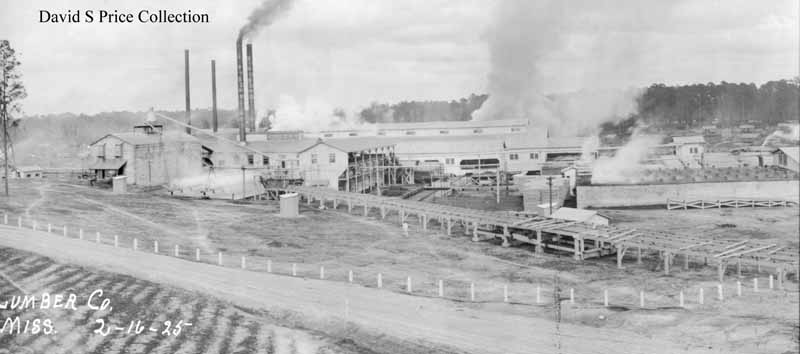 The
Virgin Pine Lumber Co. mill at Piave in 1925. This overall view looks to
the east. |
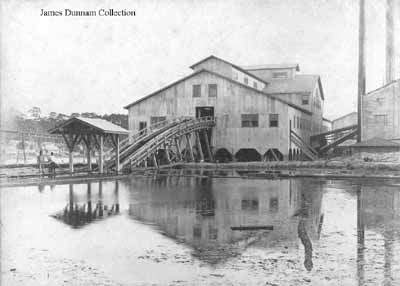
The Virgin Pine mill from the mill pond looking southeast. |

The concrete walls of the shavings vault and boiler room remain today.
The shavings vault is the far left building in the 1925 photo above. |
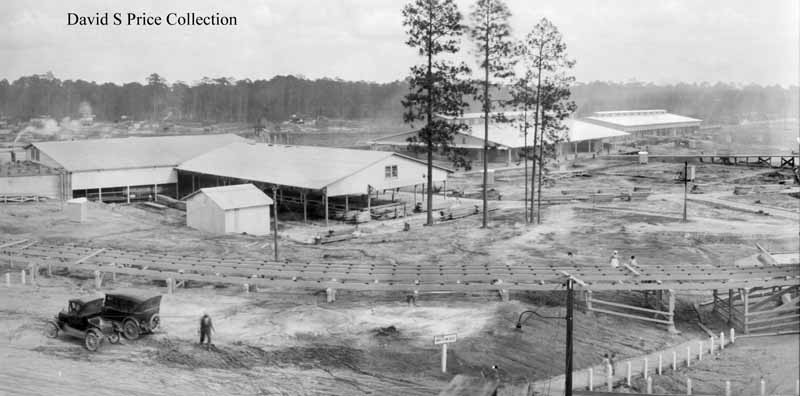
The right section of the 1925 panoramic photo show the lumber sheds and
planing mill, and looks to the southeast. |
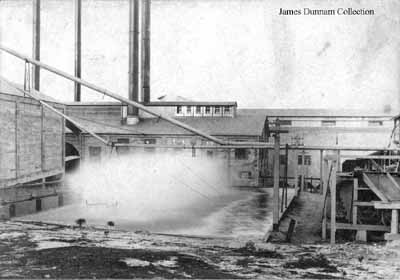
The cooling pond and boiler room. This 1920's photo is about the same
angle as the 1970's view above. |
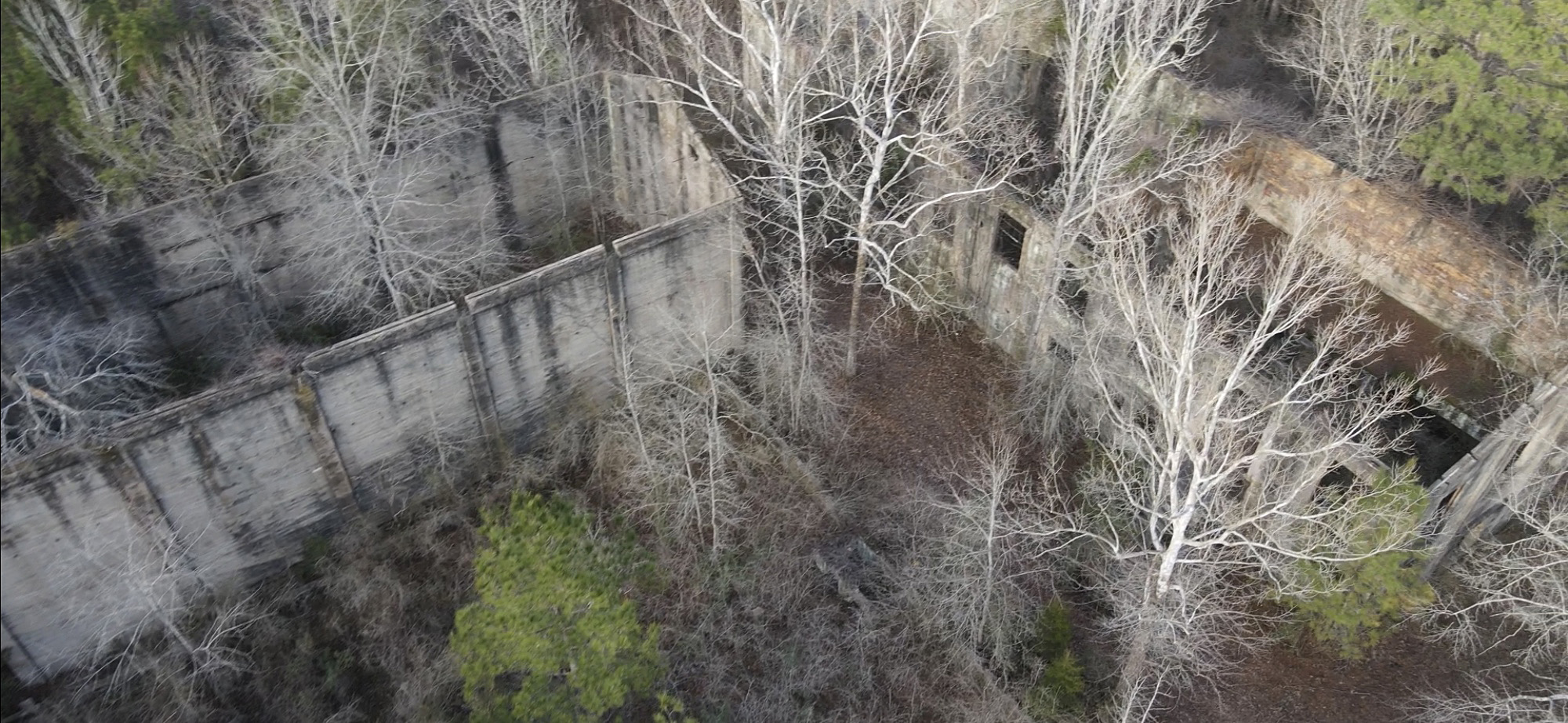 The
remaining structures at Piave in 2021. Mark Merritt Photo |
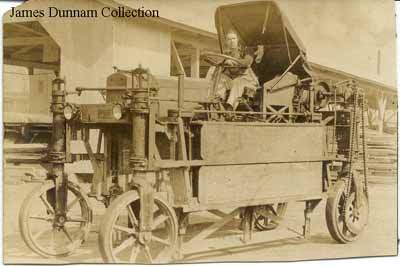
Straddle-type electric lumber carrier at Piave. |
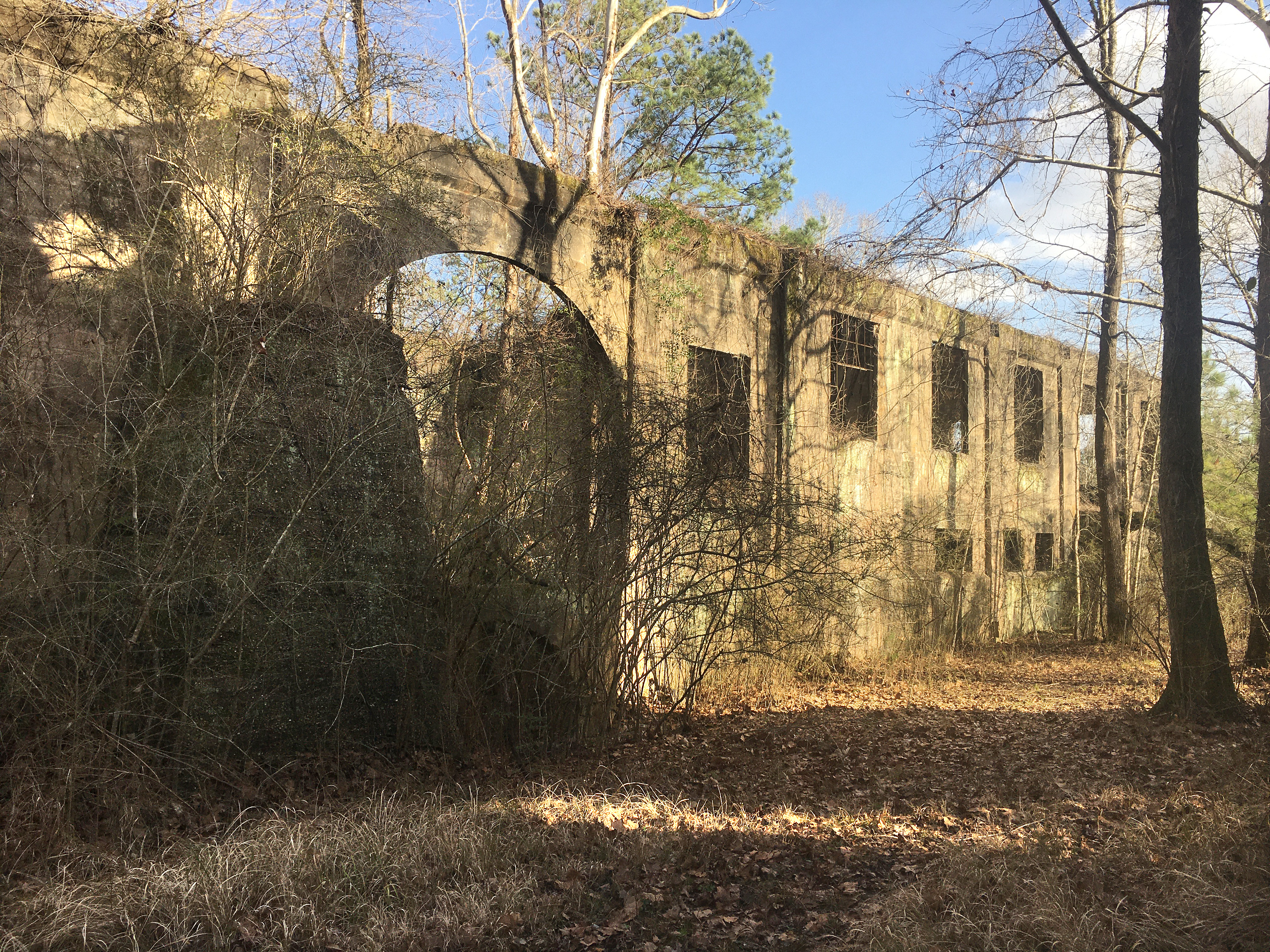
Piave 2021 Mark Merritt Photo |
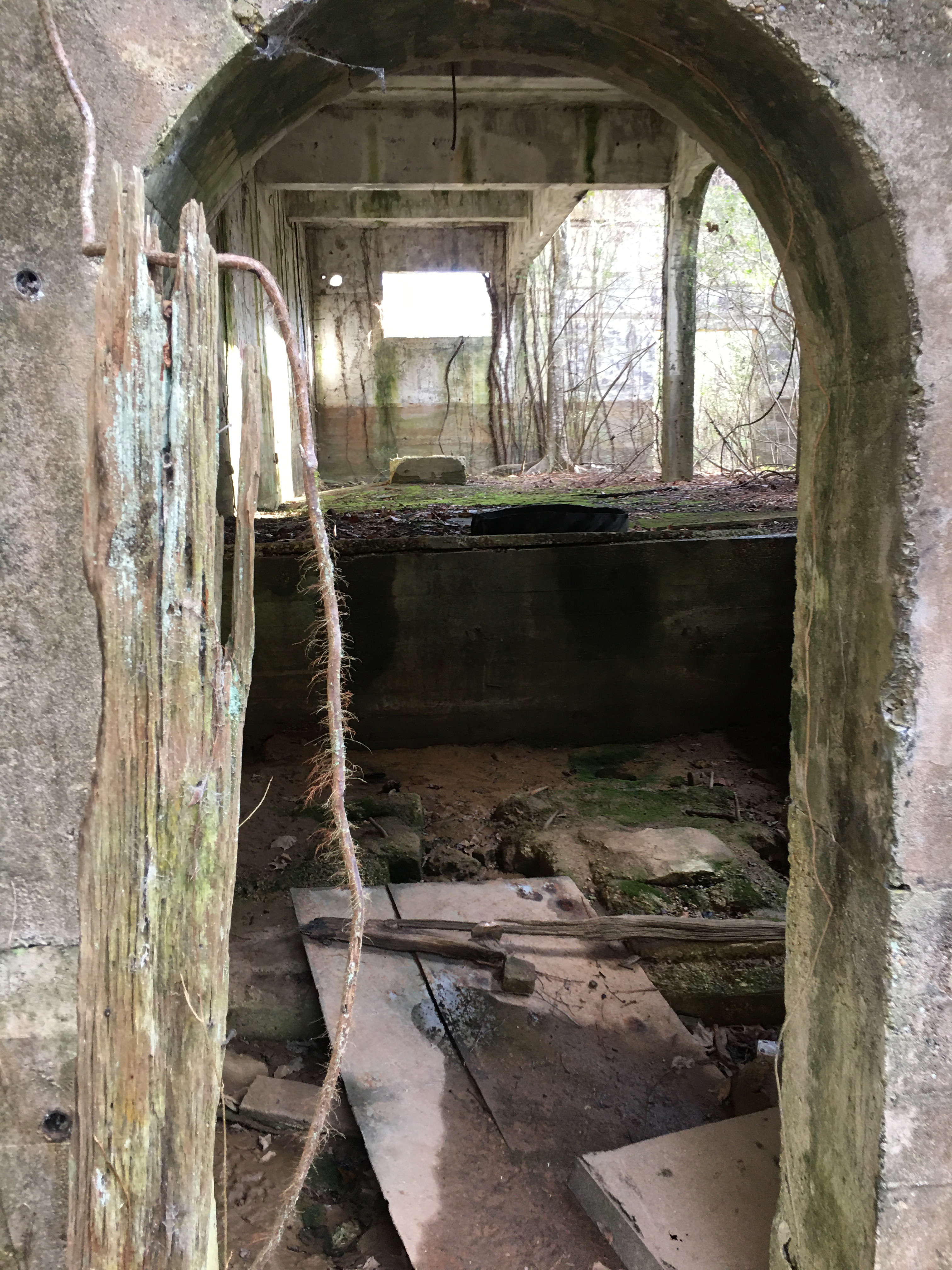
Piave 2021 Mark Merritt Photo |
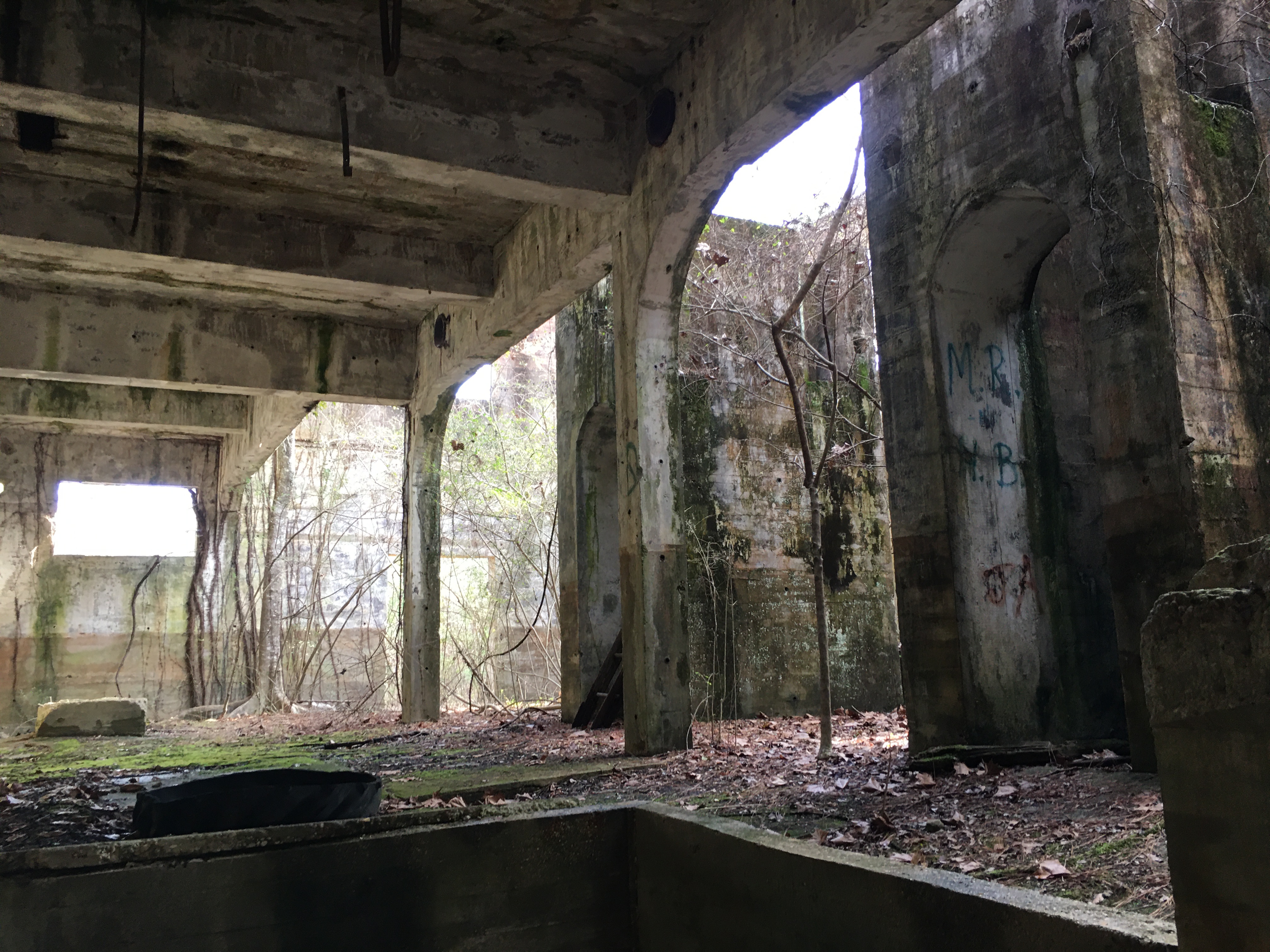
Piave 2021 Mark Merritt Photo |
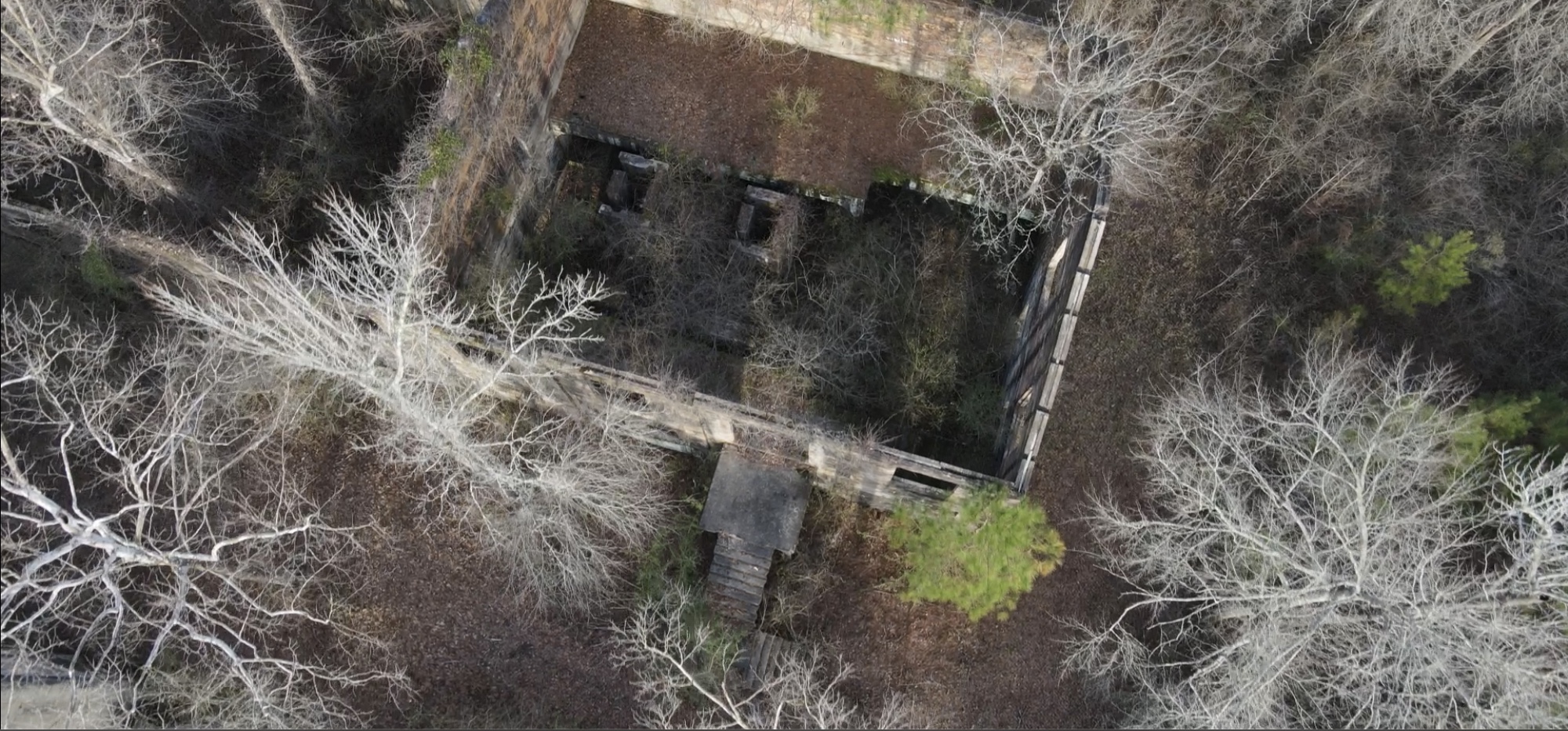
Piave 2021 Mark Merritt Photo |
|
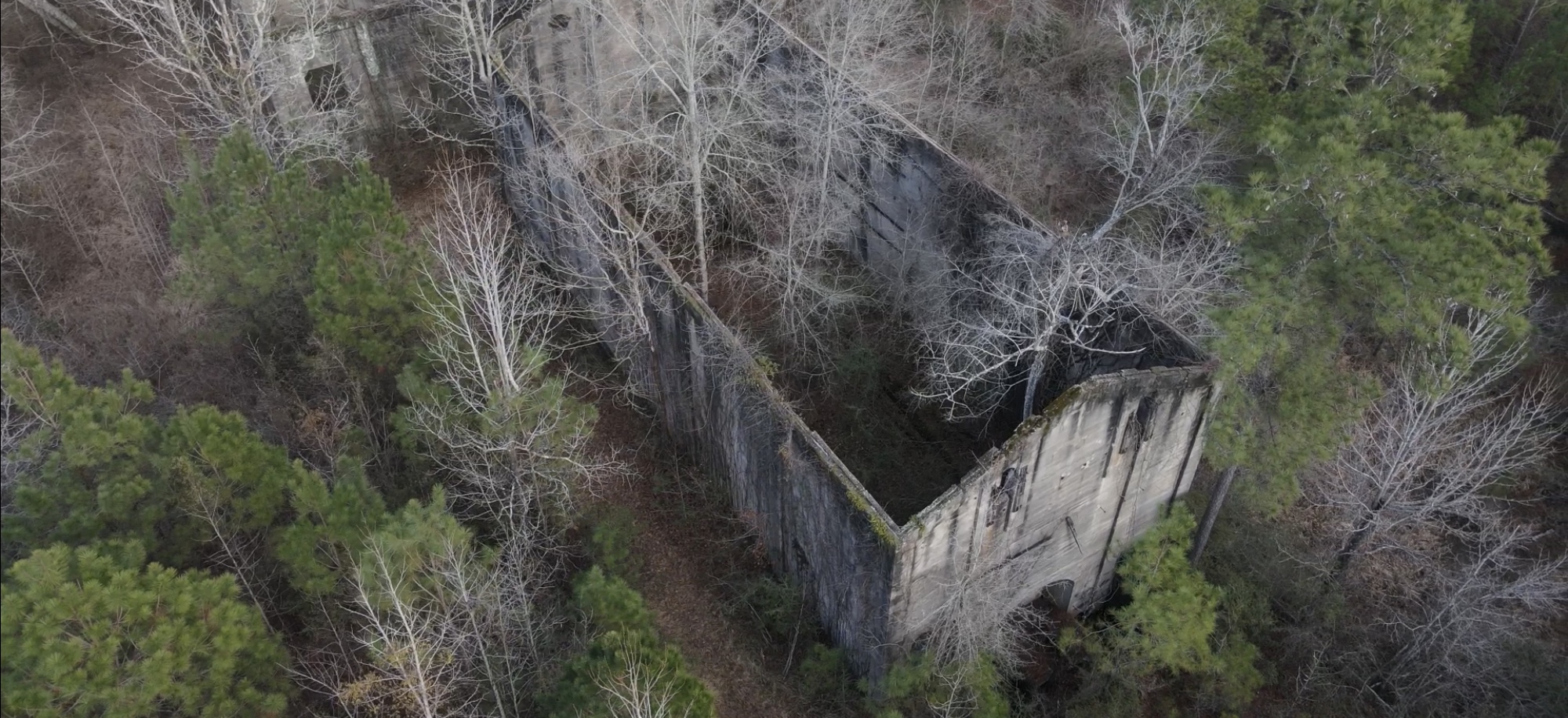
Piave 2021 Mark Merritt Photo |
| ROSTER by Gil Hoffman:
|
Road
No.
|
Type
|
Builder
|
C.N.
|
Date
|
Cyls.
|
Dri.
Dia.
|
Engine
Wt.
|
Previous
Ownership
|
Disposition
|
|
1
|
50-2
Shay
|
Lima
|
3104
|
5/1920
|
3-11x12
|
32
|
100000
|
J.
M. Griffin #2, Blodgett, MS
C.
& R. Lumber Co. #2, Blodgett, MS,
on
7/1/1921.
Virgin Pine Lumber Co. #1, on ?
|
Crosby
Lumber & Manufacturing Co. #1, Crosby, MS, ca. 1934.
Scrapped 1954.
|
|
3
|
42-2
Shay
|
Lima
|
2443
|
5/1911
|
3-10x12
|
29½
|
84000
|
Greenville
& Nolachuckey Ry. #1, Greenville, TN (John Heilman Lumber Co.)
White
Lumber Co. #1, Greenville, TN
Virgin Pine Lumber Co. #3, by 3/1920.
|
Last parts order, 8/28/1930.
|
|
4
|
36-2
Shay
|
Lima
|
2096
|
6/1908
|
3-10x10
|
28
|
72000
|
Lacey
Lumber Co. #4, Carriere, MS
Rosa
Lumber Co. #4, Picayune, MS,
in
1917.
Goodyear
Yellow Pine Co. #4, Picayune, MS
C.
& R. Lumber Co. #4, Blodgett, MS,
in
6/1922.
Virgin Pine Lumber Co. #4, in 9/1924.
|
Scrapped 1933.
|
|
11
|
60-3
Shay
|
Lima
|
3197
|
12/1922
|
3-11x12
|
32
|
133000
|
C.
& R. Lumber Co. #11, Blodgett, MS
Virgin Pine Lumber Co. #11, by
11/1929.
|
Crosby
Lumber & Manufacturing Co. #11, Crosby, MS, in 9/1937.
Retired
1958.
City
of Natchez, MS, on 4/30/1965
(for display).
|
|
15
|
50-2
Shay
|
Lima
|
2977
|
5/1918
|
3-11x12
|
32
|
100000
|
Oklahoma
Portland Cement Co. #2, Ada, OK
Virgin Pine Lumber Co. #15, in
2/1920.
|
C.
& R. Lumber Co. #15, Blodgett, MS,
by
7/1926.
Goodyear
Yellow Pine Co. #15, Picayune, MS, by 4/1931.
Crosby
Lumber & Manufacturing Co. #15, Crosby, MS, on 8/14/1944.
Re.
#1.
Pascagoula
Veneer Co. #1, Crosby, MS,
in
1957.
Thomas
Lawson, Jr., Birmingham, AL,
Eureka
Springs & North Arkansas Ry. #8, Eureka Springs, AR, in 1983.
Lowville
& Beaver River Ry. #8, Lowville, NY, in 1989.
Railway Historical Society of
Northern New York, Croghan, NY
|
|
101
|
2-6-0
|
Baldwin
|
|
|
|
|
100000
|
Unknown.
Virgin Pine Lumber Co. #101, by
2/1926.
|
|
|
HOME
ABOUT US
LINKS
For more information contact
Tony Howe at tonyhowe76@yahoo.com
or David S. Price at dsprice46@bellsouth.net
|
